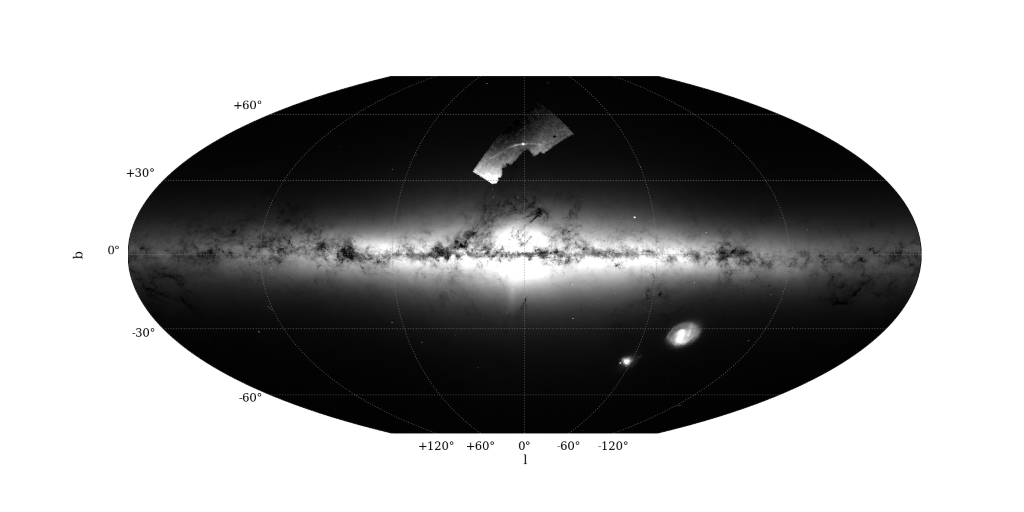Palomar 5 is known to be a special star cluster. Firstly, this is because it is considered to be one of the “fluffiest” clusters in the halo of the Milky Way Galaxy, where the average distance between the stars is a few light-years, similar to the distance from the Sun to the closest star.
 Above is an all-sky view in galactic coordinates. The number of stars is higher in brighter regions. Most of the image, where the Milky Way plane is visible (b = 0 degrees), is produced using Gaia eDR3 data. The small patch in the top-center shows a region where deeper DESI Legacy Imaging Survey (DECaLS) data is available, which allows for Palomar 5 and its tidal tails to be seen. Image Credit: M. Gieles et al./Gaia eDR3/DESI DECaLS.
Above is an all-sky view in galactic coordinates. The number of stars is higher in brighter regions. Most of the image, where the Milky Way plane is visible (b = 0 degrees), is produced using Gaia eDR3 data. The small patch in the top-center shows a region where deeper DESI Legacy Imaging Survey (DECaLS) data is available, which allows for Palomar 5 and its tidal tails to be seen. Image Credit: M. Gieles et al./Gaia eDR3/DESI DECaLS.
Secondly, it features a specular stellar stream connected with it and spanning over 20° throughout the sky. In a paper recently published in the journal Nature Astronomy, an international group of astrophysicists and astronomers guided by the University of Barcelona demonstrate that both differentiating features of Palomar 5 are probably due to an oversized black hole population of over 100 black holes at the center of the cluster.
The number of black holes is roughly three times larger than expected from the number of stars in the cluster, and it means that more than 20% of the total cluster mass is made up of black holes. They each have a mass of about 20 times the mass of the Sun, and they formed in supernova explosions at the end of the lives of massive stars, when the cluster was still very young.
Mark Gieles, Study Lead Author and Professor, Institute of Cosmos Sciences, University of Barcelona
Tidal streams are streams of stars discharged from disrupting dwarf galaxies or star clusters. Almost 30 thin streams have been found in the Milky Way halo during the past few years.
We do not know how these streams form, but one idea is that they are disrupted star clusters. However, none of the recently discovered streams have a star cluster associated with them, hence we cannot be sure. So, to understand how these streams formed, we need to study one with a stellar system associated with it. Palomar 5 is the only case, making it a Rosetta Stone for understanding stream formation and that is why we studied it in detail.
Mark Gieles, Study Lead Author and Professor, Institute of Cosmos Sciences, University of Barcelona
The orbits and the evolution of every star starting from the formation of the cluster until its final dissolution have been simulated by the researchers. The initial properties of the cluster were altered until a perfect match with observations of the stream and the cluster were achieved.
The researchers determined that Palomar 5 was developed with a lower black hole fraction, but stars escaped more efficiently compared to black holes, such that the black hole fraction increased slowly.
The black holes energetically inflated the cluster in gravitational slingshot interactions with stars, resulting in many more escaping stars and the development of the stream. Therefore, just before it entirely dissolves — approximately a billion years from now — the cluster will be made completely of black holes.
This work has helped us understand that even though the fluffy Palomar 5 cluster has the brightest and longest tails of any cluster in the Milky Way, it is not unique. Instead, we believe that many similarly puffed up, black hole-dominated clusters have already disintegrated in the Milky Way tides to form the recently discovered thin stellar streams.
Dr Denis Erkal, Study Co-Author, University of Surrey
Gieles pointed out, “We have shown that the presence of a large black hole population may have been common in all the clusters that formed the streams.”
This is essential for gaining knowledge about globular cluster formation, the initial masses of stars and the evolution of massive stars. Moreover, this study has significant implications for gravitational waves.
“It is believed that a large fraction of binary black hole mergers form in star clusters. A big unknown in this scenario is how many black holes there are in clusters, which is hard to constrain observationally because we cannot see black holes. Our method gives us a way to learn how many BHs there are in a star cluster by looking at the stars they eject,” stated Dr. Fabio Antonini from Cardiff University, a co-author of the paper.
Walter Baade discovered Palomar 5, a globular cluster, in 1950. It is located in the Serpens constellation at a distance of around 80,000 light-years. It is one of the approximately 150 globular clusters orbiting around the Milky Way.
It is aged more than 10 billion years, similar to many of the other globular clusters, implying that it developed in the first phases of galaxy development. It is around 10 times less huge and 5 times more expanded compared to a normal globular cluster. It is in the final stages of dissolution.
N-body simulation of the Galactic globular cluster Palomar 5 and its stream
Simulation showing the formation of the tidal streams of the Palomar 5 cluster and the distribution of blackholes. The stars are shown in yellow and the black holes in black. Video Credit: University of Barcelona.
Journal Reference:
Gieles, M., et al. (2021) A supra-massive population of stellar-mass black holes in the globular cluster Palomar 5. Nature Astronomy. doi.org/10.1038/s41550-021-01392-2.